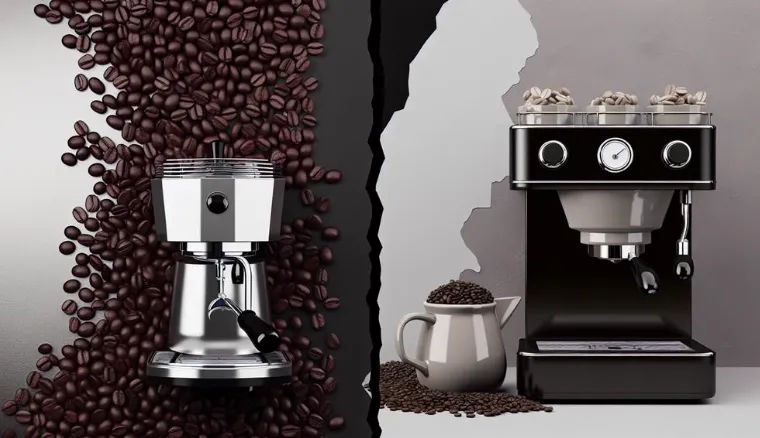The Ultimate Brew-Off: Espresso Beans Vs. Coffee Beans

In the ultimate showdown between espresso beans vs coffee beans, you’ve got to consider more than just the grind. While both beans can come from similar origins, the real game-changer lies in their roasting and brewing processes. Espresso beans are roasted darker, giving them a robust flavor that stands up to the intense pressure and heat of espresso machines. On the other hand, coffee beans are often lighter, aimed to suit a variety of brewing methods, each highlighting different aspects of the bean’s character. So, what’ll it be for your morning ritual? Let’s explore how these differences play out in your cup.
Contents
Origins and Varieties
Espresso and coffee beans both originate from the Coffea plant, yet they’re cultivated across various global regions, each imparting its unique flavor profile influenced by the distinct climate and soil conditions. The art of bean cultivation is deeply rooted in the geography and heritage of each region, determining not just the taste but also the very identity of every bean you savor.
In Ethiopia, the birthplace of coffee, you’ll encounter beans bursting with floral and fruity notes, grown predominantly in the wild, amidst diverse plant species which contribute to their complex aromatics. Contrast this with the beans from the volcanic soils of Guatemala, where the nutrient-rich earth imparts a deep, chocolaty flavor that’s robust yet smooth.
Harvesting methods too play a pivotal role in defining the bean’s character. Most coffee is harvested using one of two methods: strip picking, where all cherries are removed from the branch at once, or selective picking, where only the ripe cherries are painstakingly chosen. Selective picking, prevalent in regions producing high-quality beans, ensures that each bean reaching your cup is at its peak of flavor, promising a superior brew.
As you delve deeper into the world of coffee, you’ll learn that each bean tells a story of its origin, shaped by hands that know the land and perfected by traditions that date back centuries.
Processing and Preparation
Once harvested, the beans undergo a crucial transformation through various processing methods, each significantly affecting the final flavor profile of your coffee. The journey of bean selection is pivotal; it’s not merely about choosing between Arabica or Robusta, but understanding the subtleties that each bean offers to either espresso or regular coffee. You’re not just picking a bean; you’re curating the essence of your next cup.
The processing method—whether washed, honey, or natural—plays a profound role. Washed beans, often crisper and more acidic, might lead you to a lively espresso. In contrast, the sweeter, wilder notes of natural-processed beans could enhance your drip coffee experience. It’s this meticulous attention to detail in processing that primes your beans for their ultimate purpose.
Now, let’s talk grinding differences. For espresso, you’ll need a fine grind, almost powdery, which is crucial for creating that rich, creamy espresso shot with a robust flavor. Regular coffee brewing, however, calls for a coarser grind, which allows for a cleaner and clearer taste, letting the water extract flavors more evenly. You’re sculpting the grind size to match the brewing method, ensuring that each sip is a testament to your craft and dedication.
Roasting Differences
After selecting and grinding your beans, the next step is mastering the art of roasting, which significantly shapes the flavor and quality of your coffee. The differences in roasting for espresso versus standard coffee beans are pronounced and critical.
Espresso beans typically undergo a darker roast to achieve a bold, rich flavor that stands up to the intense extraction process of espresso machines. This darker roast reduces the acidity and enhances the bean’s natural oils, which are crucial for producing the signature crema and full-bodied taste.
In contrast, beans meant for regular coffee can be roasted to various degrees depending on the desired flavor profile, from light to medium to dark. Lighter roasts retain more of the bean’s original characteristics and complexities, while darker roasts emphasize a deeper, smokier flavor.
The choice of roasting equipment plays a pivotal role in this process. High-quality roasters allow for precise control over temperature and timing, which are essential for achieving consistent results. You’ll want to choose equipment that supports the specific needs of your bean selection—whether aiming for the consistent heat necessary for espresso’s dark roasts or the adjustable settings required for crafting the perfect cup of coffee.
Brewing Techniques Compared
Diving into the world of coffee brewing, you’ll find that techniques vary significantly between preparing espresso and regular coffee, each method tailored to enhance the unique characteristics of the beans.
For espresso, the grind size is crucially fine, almost powder-like, which ensures a slow water passage and optimal extraction of flavor. In contrast, regular coffee brewing uses a coarser grind, which allows for a faster water flow and a different extraction dynamic.
You’ll also discover that water temperature plays a pivotal role in defining the brew’s quality. For espresso, the water needs to be just off-boil, typically between 90°C to 96°C. This high temperature, coupled with the fine grind, extracts the coffee quickly and efficiently, resulting in the rich crema and concentrated flavor that espresso is renowned for. On the other hand, brewing regular coffee usually involves slightly cooler water, around 87°C to 93°C, which suits the coarser grind and prevents over-extraction, keeping the coffee smooth and balanced.
Understanding these nuances, you realize that mastery in coffee brewing isn’t just about following steps; it’s about precision and adaptation to the bean’s nature, ensuring every cup you brew is as delightful as intended.
Flavor Profiles and Characteristics
Understanding the brewing techniques, let’s now explore the distinct flavor profiles and characteristics that set espresso apart from regular coffee. You’ll find that espresso beans are often roasted longer and darker compared to those used for regular coffee. This intense roasting process reduces the bean acidity, which is crucial in achieving the bold, rich flavor you expect from a high-quality espresso shot. The darker roast also enhances the aromatic intensity, unleashing a powerful bouquet of smoky, caramelized tones that captivate your senses.
Regular coffee beans, on the other hand, are typically roasted to a lighter degree, preserving more of the bean’s natural acidity. This higher acidity level contributes to the bright, vibrant flavors you savor in your morning cup, ranging from fruity to floral notes. The aromatic intensity is generally less pronounced than in espresso, offering a subtler, more nuanced fragrance that complements its complex flavor spectrum.
It’s this contrast in acidity and aromatic intensity that essentially defines your coffee experience. Whether you crave the bold, robust punch of an espresso or the delicate, refined elegance of a brewed coffee, understanding these profiles helps you appreciate the art and science behind your favorite cup.


